



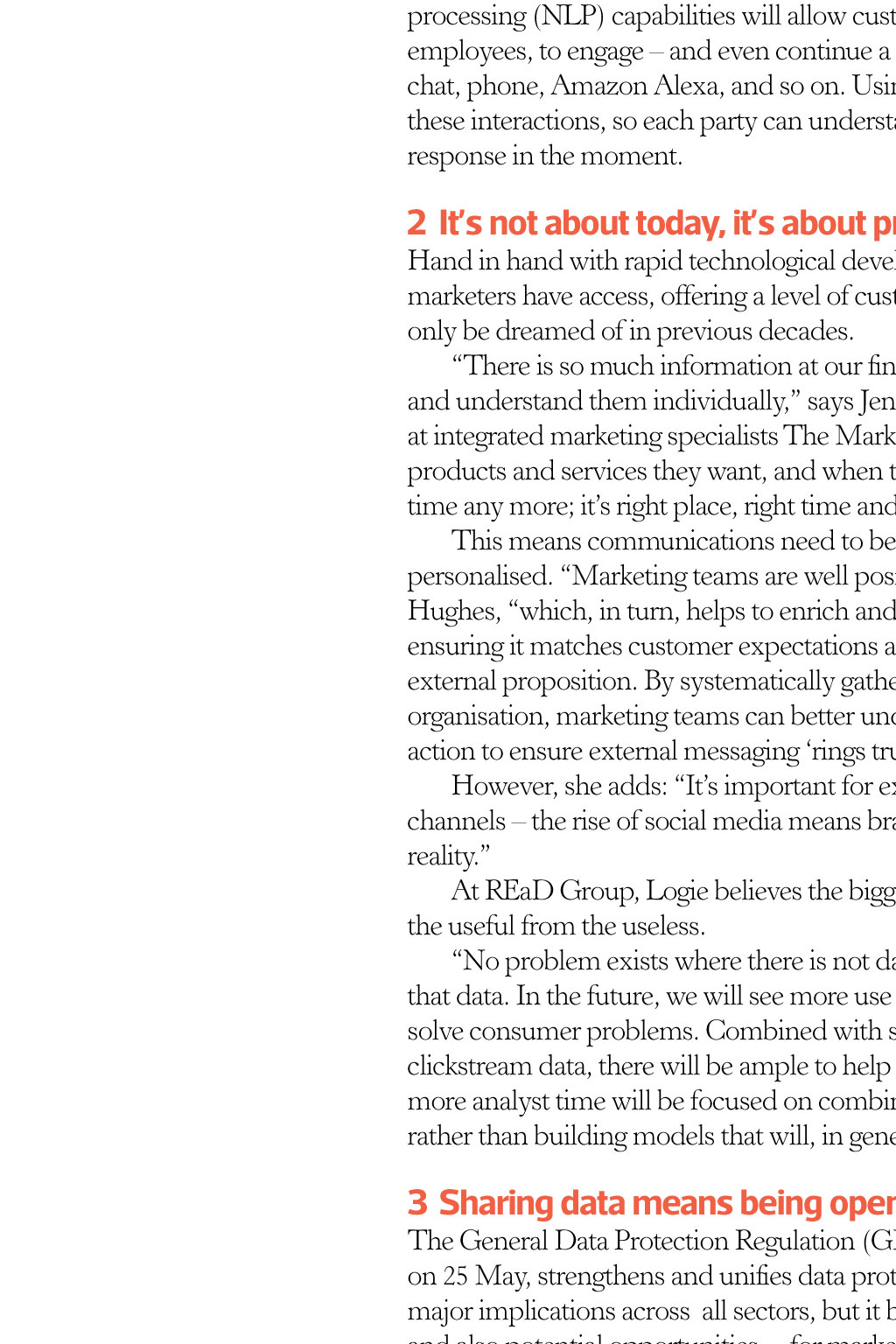
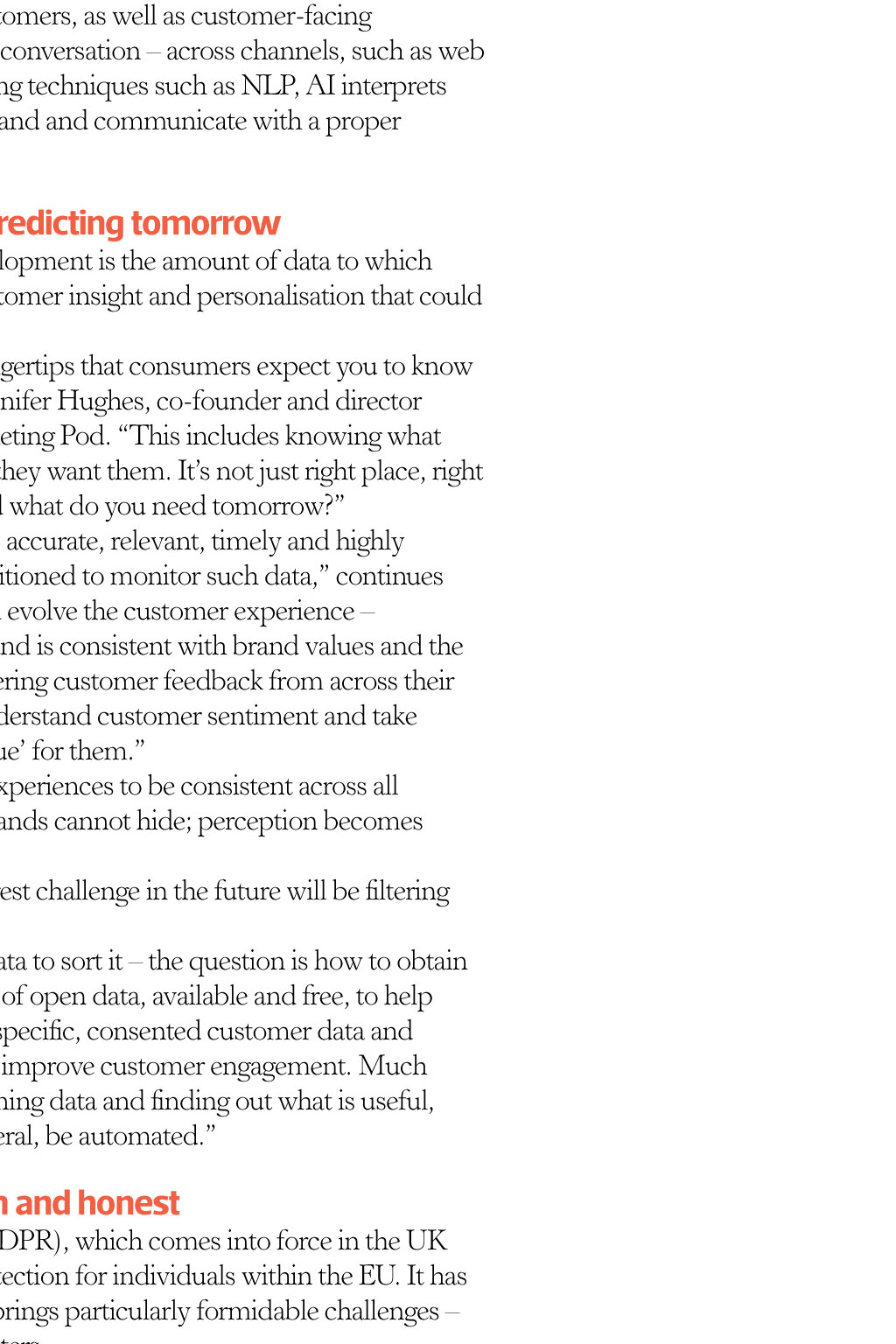
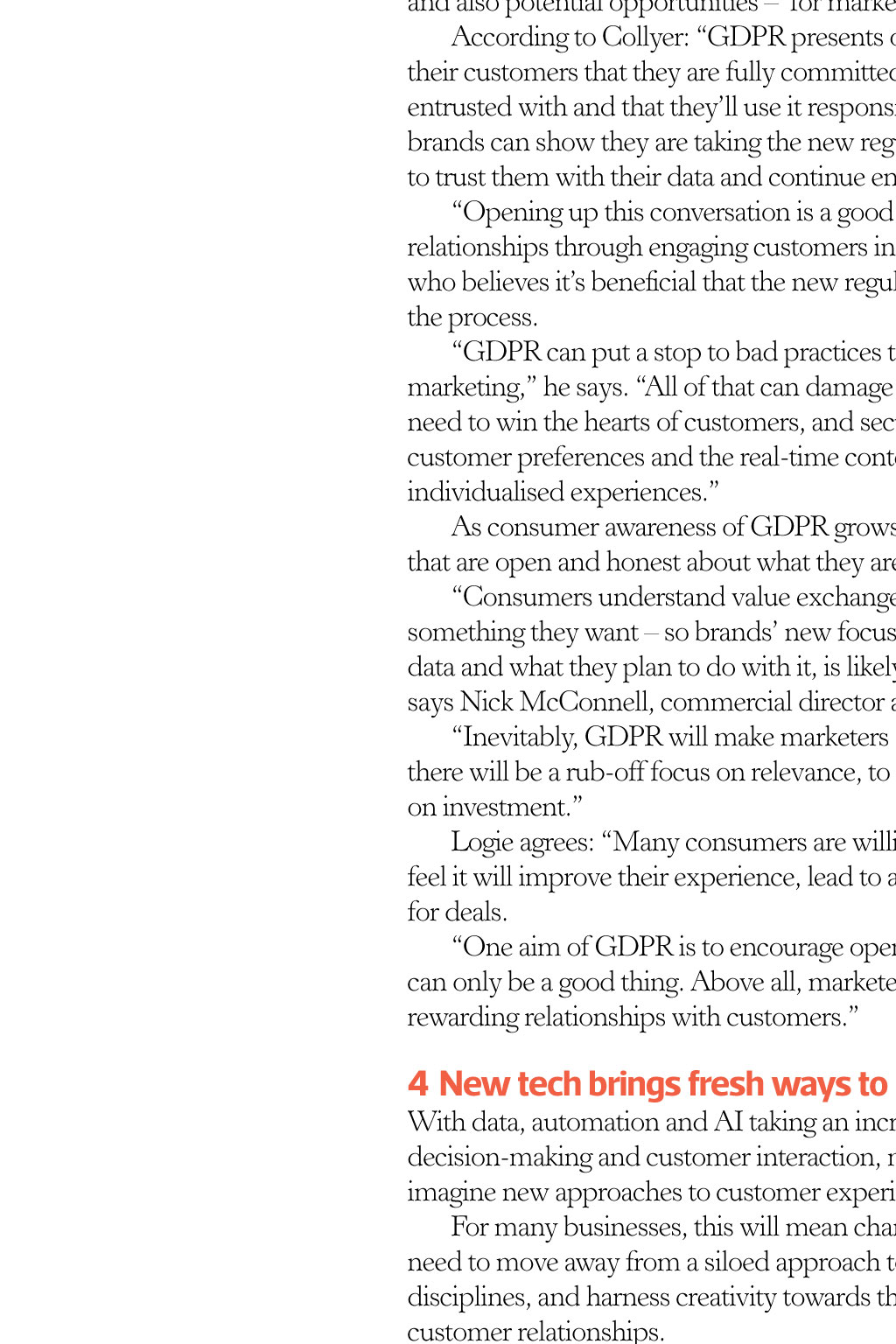
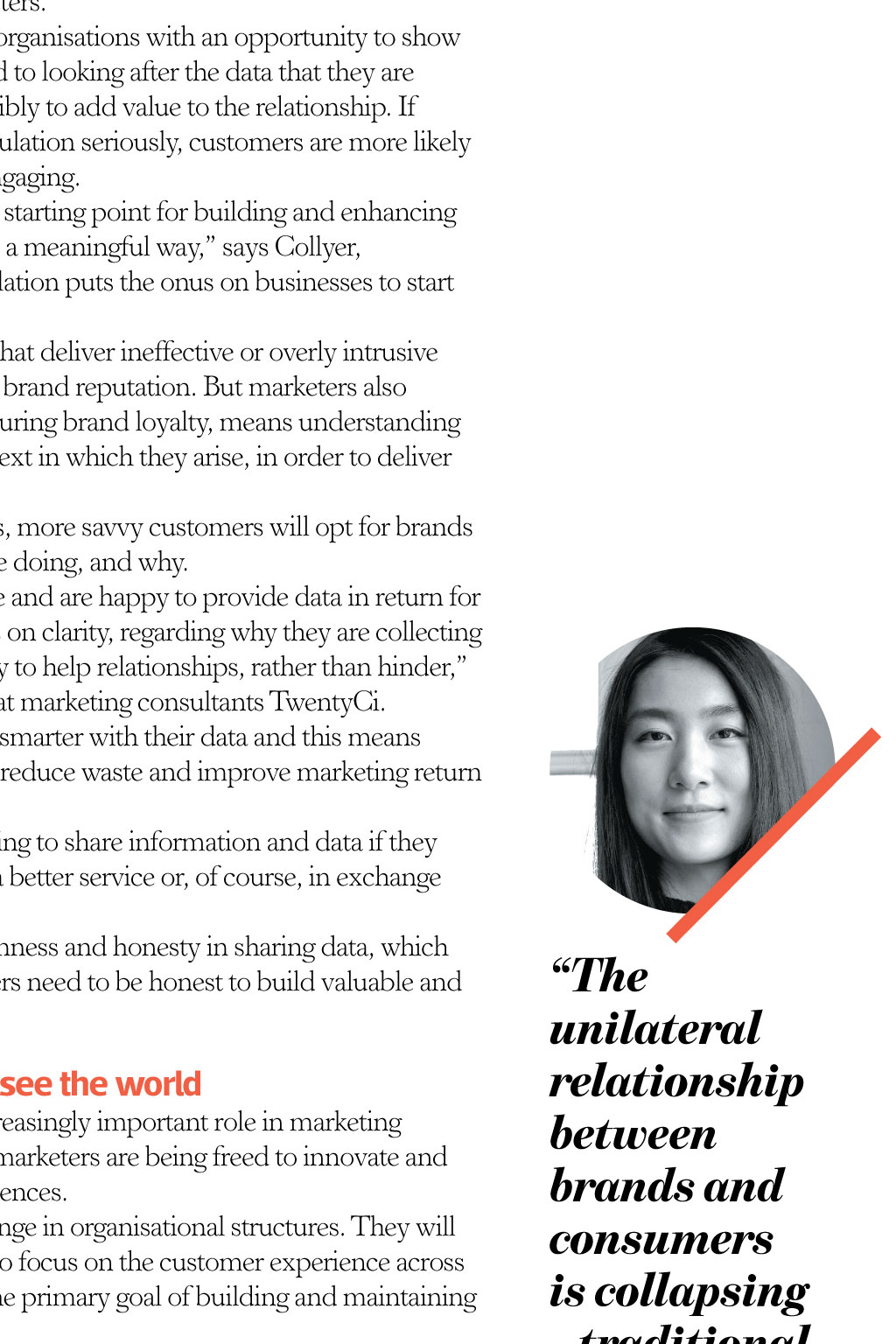
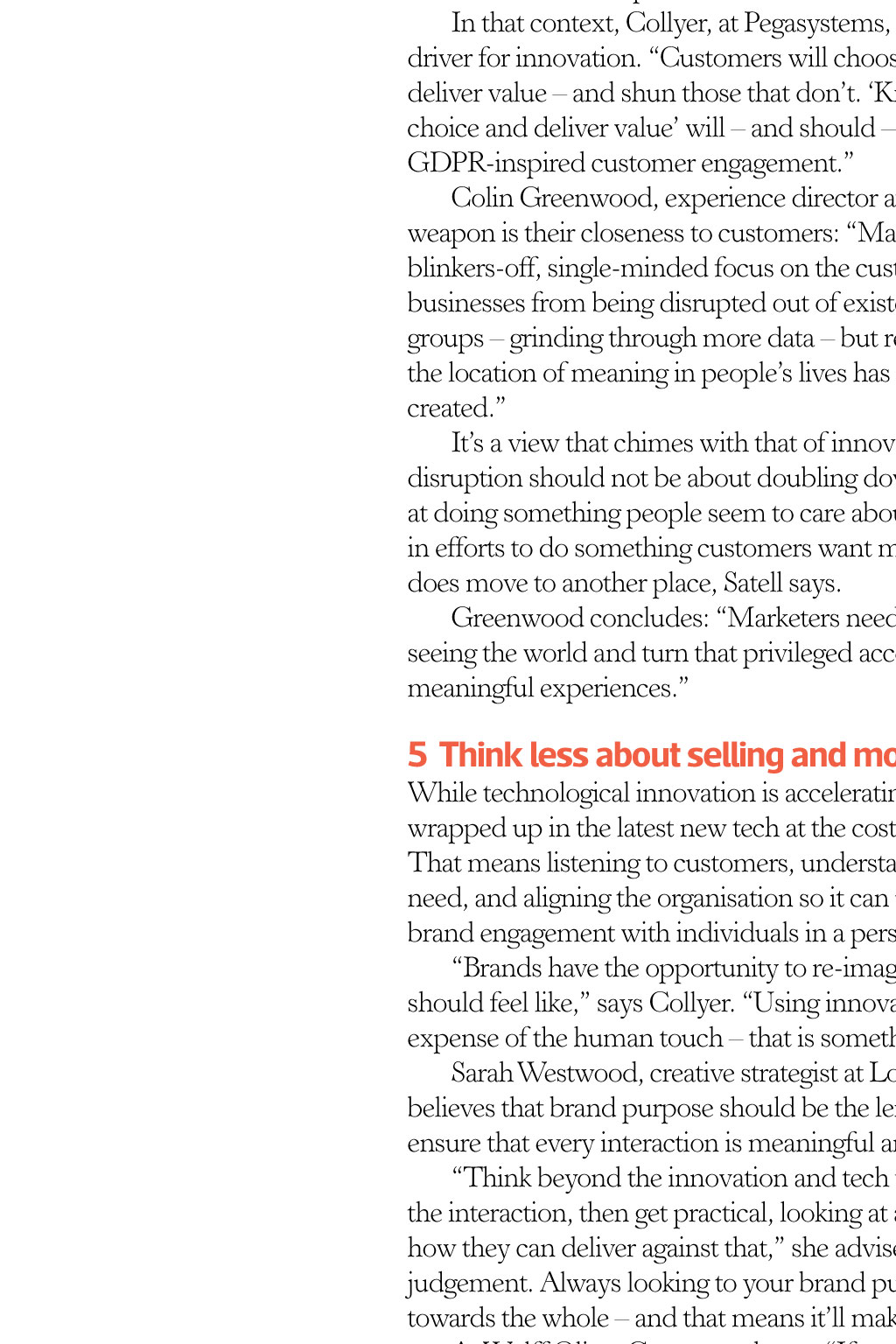
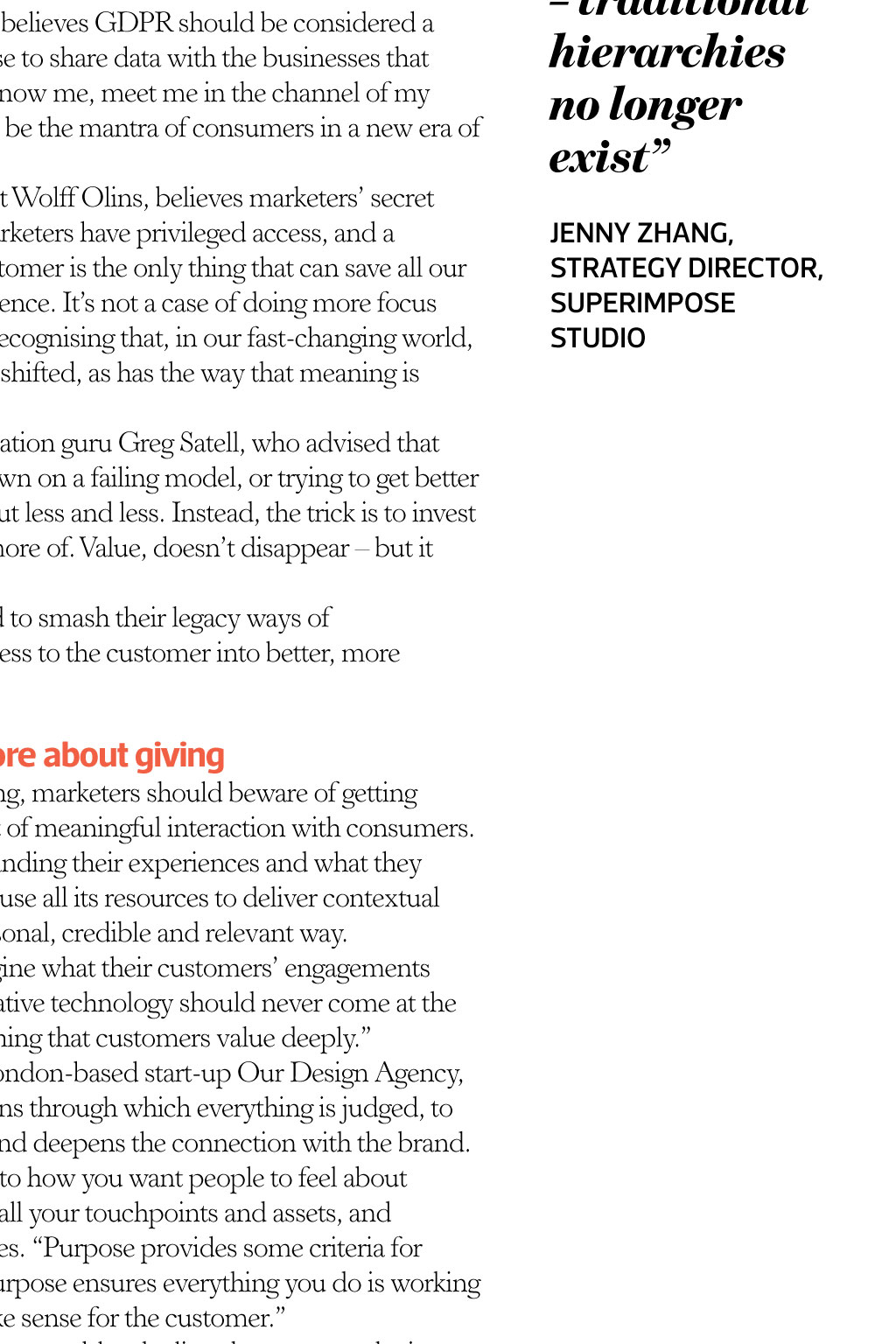
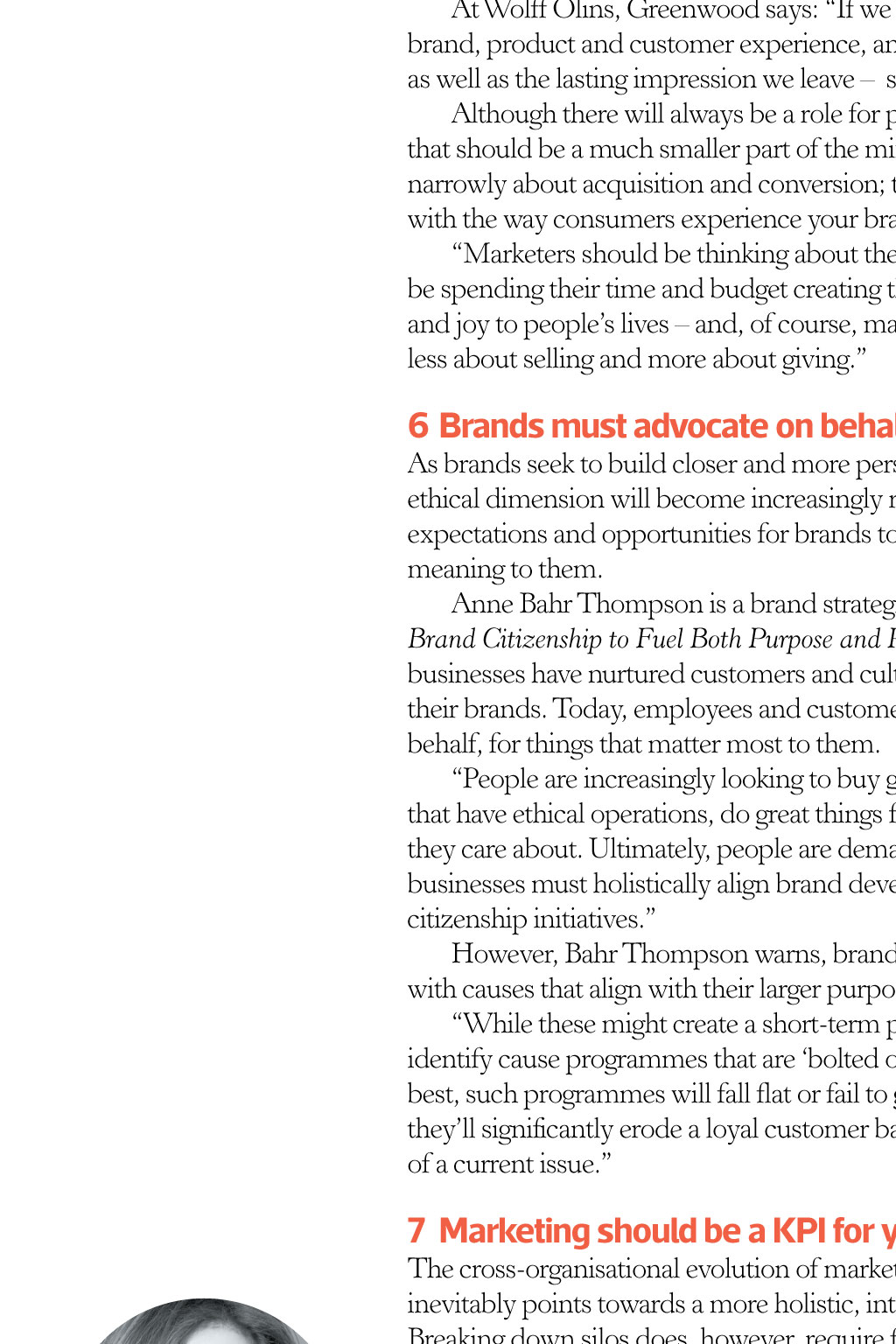

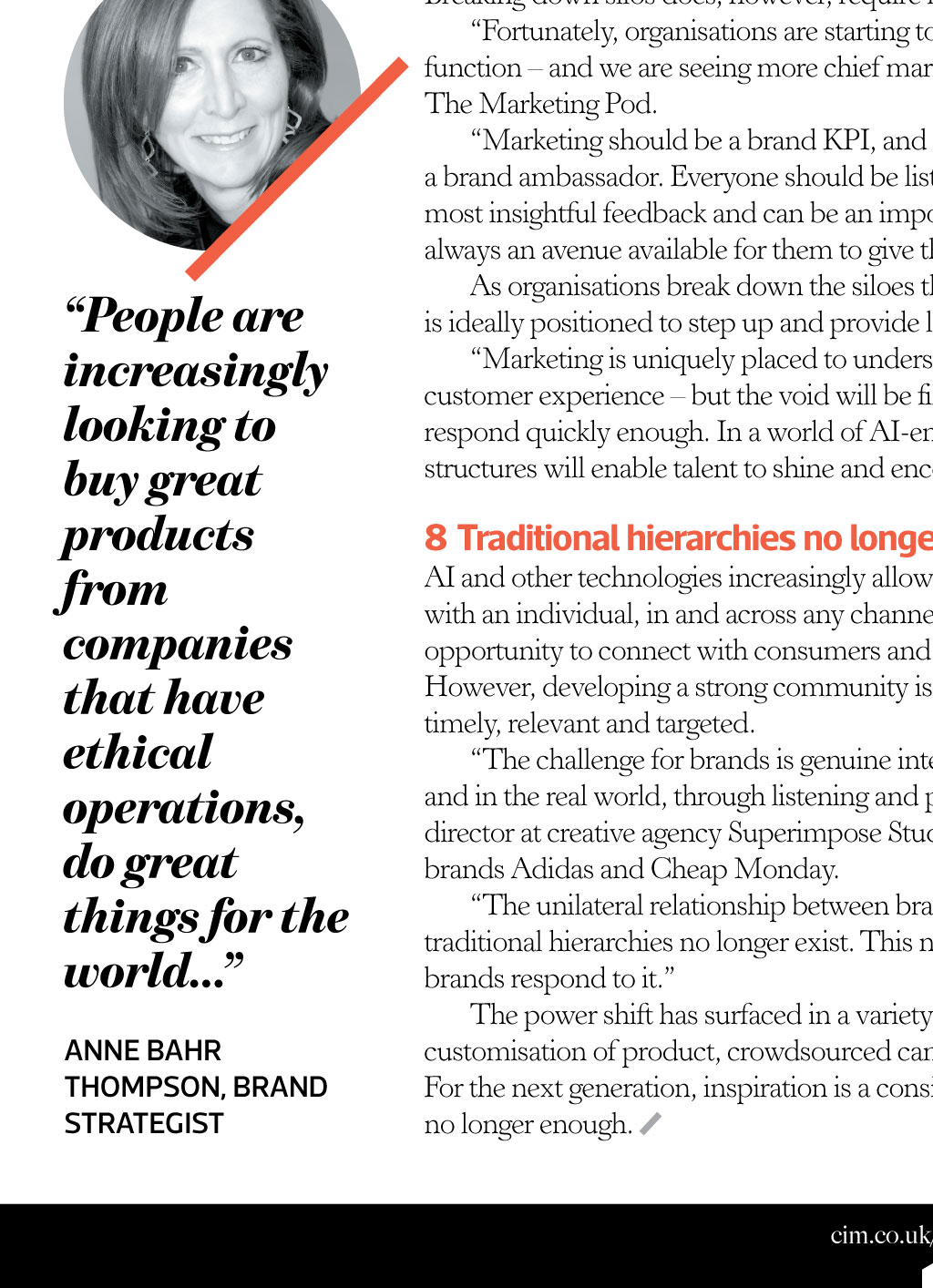
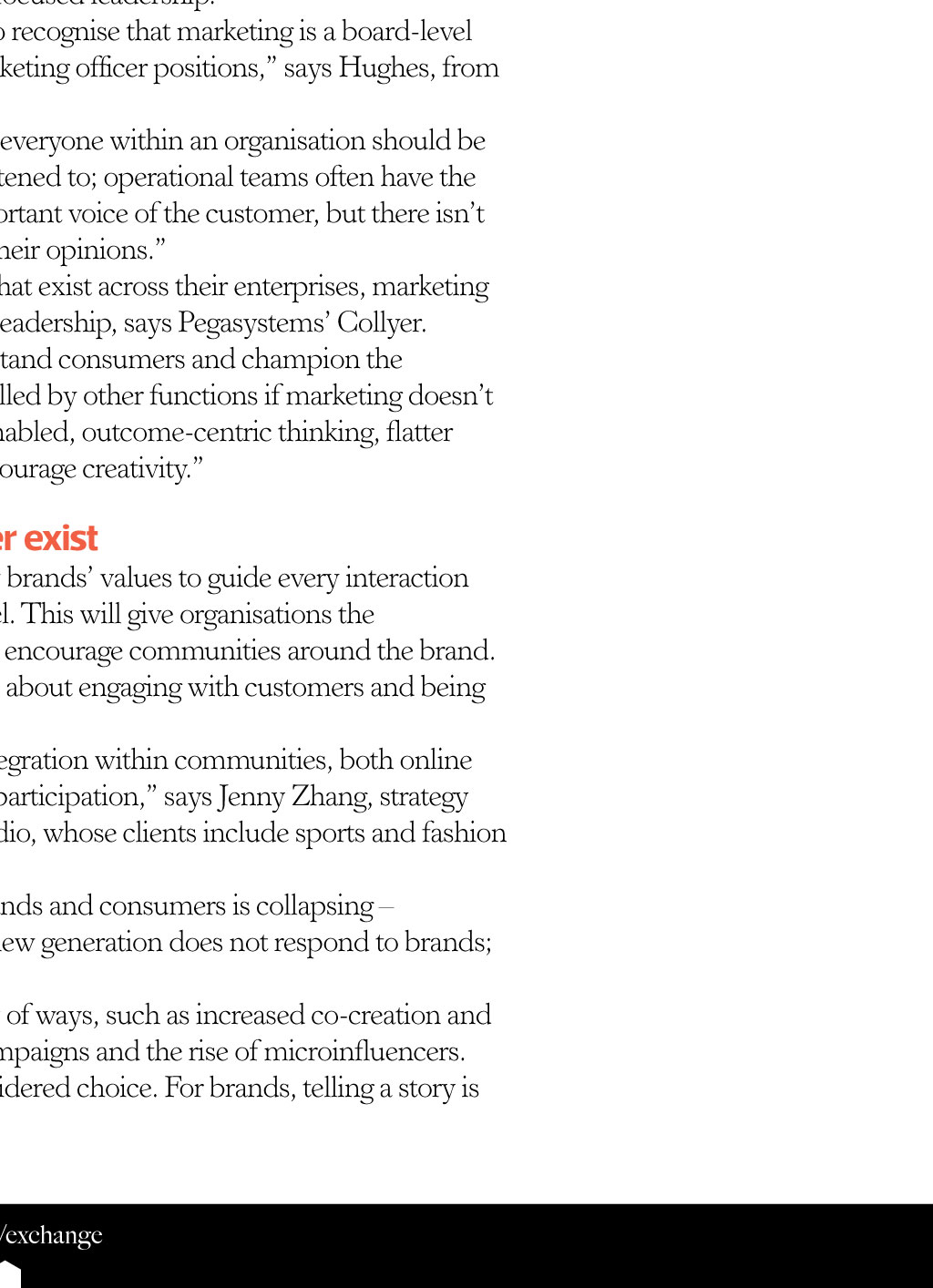















Report Caught in the rush of the future The future is rushing towards marketing at incredible speed. As it hurtles towards us, traditional certainties and hierarchies are overturned the user journey fragments across channels; consumers become vocal in their demand for marketings time and attention, whenever or wherever they want it. They expect more, including some products and services for free. They see the world in new ways through the prism of augmented and virtual reality and, in return for their interactions, ask brands to deliver transparency and work towards some social good beyond profit. In the midst of all this change, one central tenet of marketing holds firm the relationship between the marketer and the customer. Marketing becomes a key performance indicator of a businesss potential to meet consumer expectations. Here, we highlight eight ways that good customer relations can be built in this challenging environment, exploring what is affecting those relationships today, and what future consumers will want and expect from their brands tomorrow Words: Phil Lattimore 1New technologies are remodelling the customer journey Customers understand value exchange and are happy to provide data in return for something they want... Nick McConnell, communications director, twentyCi Technology is already playing a pivotal role in fostering strong relationships between marketers and customers, by helping to streamline and improve the customer experience, says Scott Logie, customer engagement director at data communications company REaD Group. A recent DMA [Direct Marketing Association] report on customer engagement, focusing on the travel sector, has revealed that most consumers welcome the use of technology to build better engagement with a brand and this is not restricted to younger generations. Indeed, marketers are already witnessing a shift in attitude towards real-world applications of technology that is only set to increase across demographics and sectors of interest. In more advanced technology, virtual reality (VR) and augmented reality (AR) present new channels for brands to show what they offer. We are already witnessing this with the likes of Ikea and its Place AR app, which lets people put virtual furniture into a real world, Logie says. Consumers are interested in using augmented reality to enhance their experience. Understanding the impact of technology is, however, crucial, says Tim Jones, managing director at digital marketing agency True Digital: Marketers will need to harness information and understand how this technology is changing user journeys to cater for, and personalise, experiences in an automated world. There are a lot of questions arising from tech innovation that marketers will need to address challenges such as maintaining the human brand when messaging is delivered via robo-marketing; customer uncertainty about artificial intelligence (AI); and ensuring tech implementation doesnt leave customers in the dark. Research in the financial technology (fintech) sector, for instance, suggests even digitally savvy 18 to 55-year-olds are sceptical that AI could ever be better at giving advice than a qualified professional, reflecting that human imperative. Robin Collyer, marketing and decisioning specialist at customer relationship management (CRM) software company Pegasystems, identifies augmented intelligence the role of AI in assisting humans in the workplace as an area of growing interest. New technologies will enable CRM systems to apply augmented intelligence to any customer interaction, analyse that interaction, and quickly recommend the next step to take with that individual customer empowering customer-facing staff to engage in an increasingly human way. Collyer says emerging conversational interfaces with advanced natural language processing (NLP) capabilities will allow customers, as well as customer-facing employees, to engage and even continue a conversation across channels, such as web chat, phone, Amazon Alexa, and so on. Using techniques such as NLP, AI interprets these interactions, so each party can understand and communicate with a proper response in the moment. The speed read New technologies are remodelling the customer journey Data can help brands predict future customer behaviour Giving and advocacy will become key tools for marketersg Automated systems excel at serving personalised communications to a mass audience Think in terms of the customer life-cycle, instead of conversion 2Its not about today, its about predicting tomorrow Hand in hand with rapid technological development is the amount of data to which marketers have access, offering a level of customer insight and personalisation that could only be dreamed of in previous decades. There is so much information at our fingertips that consumers expect you to know and understand them individually, says Jennifer Hughes, co-founder and director at integrated marketing specialists The Marketing Pod. This includes knowing what products and services they want, and when they want them. Its not just right place, right time any more; its right place, right time and what do you need tomorrow? This means communications need to be accurate, relevant, timely and highly personalised. Marketing teams are well positioned to monitor such data, continues Hughes, which, in turn, helps to enrich and evolve the customer experience ensuring it matches customer expectations and is consistent with brand values and the external proposition. By systematically gathering customer feedback from across their organisation, marketing teams can better understand customer sentiment and take action to ensure external messaging rings true for them. However, she adds: Its important for experiences to be consistent across all channels the rise of social media means brands cannot hide; perception becomes reality. At REaD Group, Logie believes the biggest challenge in the future will be filtering the useful from the useless. No problem exists where there is not data to sort it the question is how to obtain that data. In the future, we will see more use of open data, available and free, to help solve consumer problems. Combined with specific, consented customer data and clickstream data, there will be ample to help improve customer engagement. Much more analyst time will be focused on combining data and finding out what is useful, rather than building models that will, in general, be automated. 3Sharing data means being open and honest The General Data Protection Regulation (GDPR), which comes into force in the UK on 25 May, strengthens and unifies data protection for individuals within the EU. It has major implications across all sectors, but it brings particularly formidable challenges and also potential opportunities for marketers. According to Collyer: GDPR presents organisations with an opportunity to show their customers that they are fully committed to looking after the data that they are entrusted with and that theyll use it responsibly to add value to the relationship. If brands can show they are taking the new regulation seriously, customers are more likely to trust them with their data and continue engaging. Opening up this conversation is a good starting point for building and enhancing relationships through engaging customers in a meaningful way, says Collyer, whobelieves its beneficial that the new regulation puts the onus on businesses to start theprocess. GDPR can put a stop to bad practices that deliver ineffective or overly intrusive marketing, he says. All of that can damage brand reputation. But marketers also need to win the hearts of customers, and securing brand loyalty, means understanding customer preferences and the real-time context in which they arise, in order to deliver individualised experiences. As consumer awareness of GDPR grows, more savvy customers will opt for brands that are open and honest about what they are doing, and why. Consumers understand value exchange and are happy to provide data in return for something they want so brands new focus on clarity, regarding why they are collecting data and what they plan to do with it, is likely to help relationships, rather than hinder, says Nick McConnell, commercial director at marketing consultants TwentyCi. Inevitably, GDPR will make marketers smarter with their data and this means therewill be a rub-off focus on relevance, to reduce waste and improve marketing return on investment. Logie agrees: Many consumers are willing to share information and data if they feel it will improve their experience, lead to a better service or, of course, in exchange fordeals. One aim of GDPR is to encourage openness and honesty in sharing data, which can only be a good thing.Above all, marketers need to be honest to build valuable and rewarding relationships with customers. 4New tech brings fresh ways to see the world With data, automation and AI taking an increasingly important role in marketing decision-making and customer interaction, marketers are being freed to innovate and imagine new approaches to customerexperiences. For many businesses, this will mean change in organisational structures. They will need to move away from a siloed approach to focus on the customer experience across disciplines, and harness creativity towards the primary goal of building and maintaining customer relationships. In that context, Collyer, at Pegasystems, believes GDPR should be considered a driver for innovation. Customers will choose to share data with the businesses that deliver value and shun those that dont. Know me, meet me in the channel of my choice and deliver value will and should be the mantra of consumers in a new era of GDPR-inspired customer engagement. Colin Greenwood, experience director at Wolff Olins, believes marketers secret weapon is their closeness to customers: Marketers have privileged access, and a blinkers-off, single-minded focus on the customer is the only thing that can save all our businesses from being disrupted out of existence. Its not a case of doing more focus groups grinding through more data but recognising that, in our fast-changing world, the location of meaning in peoples lives has shifted, as has the way that meaning is created. Its a view that chimes with that of innovation guru Greg Satell, who advised that disruption should not be about doubling down on a failing model, or trying to get better at doing something people seem to care about less and less. Instead, the trick is to invest in efforts to do something customers want more of. Value, doesnt disappear but it does move to another place, Satell says. Greenwood concludes: Marketersneed to smash their legacy ways of seeing the world and turn that privileged access to the customer intobetter,more meaningfulexperiences. 5Think less about selling and more about giving While technological innovation is accelerating, marketers should beware of getting wrapped up in the latest new tech at the cost of meaningful interaction with consumers. That means listening to customers, understanding their experiences and what they need, and aligning the organisation so it can use all its resources to deliver contextual brand engagement with individuals in a personal, credible and relevant way. Brands have the opportunity to re-imagine what their customers engagements should feel like, says Collyer. Using innovative technology should never come at the expense of the human touch that is something that customers value deeply. Sarah Westwood, creative strategist at London-based start-up Our Design Agency, believes that brand purpose should be the lens through which everything is judged, to ensure that every interaction is meaningful and deepens the connection with the brand. Think beyond the innovation and tech to how you want people to feel about theinteraction, then get practical, looking at all your touchpoints and assets, and how they can deliver against that, she advises. Purpose provides some criteria for judgement. Always looking to your brand purpose ensures everything you do is working towards the whole and that means itll make sense for the customer. At Wolff Olins, Greenwood says: If we start to blur the lines between marketing, brand, product and customer experience, and focus purely on the meaning we create as well as the lasting impression we leave suddenly were swimming with the tide. Although there will always be a role for paying to get peoples attention, he believes that should be a much smallerpart of the mix. Marketers should not be thinking narrowly about acquisition and conversion; to do so puts you fundamentally at odds with the way consumers experience your brand. Marketers should be thinkingabout the whole customer life-cycle. They should be spending their time and budget creatingthe kinds of experiences that bring meaning and joy to peoples lives and, of course, making a healthy return in the process. Think less about selling and more about giving. 6Brands must advocate on behalf of customers As brands seek to build closer and more personal engagement with consumers, the ethical dimension will become increasingly relevant both in terms of customer expectations and opportunities for brands to engage with people in areas that have meaning to them. Anne Bahr Thompson is a brand strategist and author of Do Good Embracing Brand Citizenship to Fuel Both Purpose and Profit. She explains: Traditionally, businesses have nurtured customers and cultivated employees who will advocate for their brands. Today, employees and customers are looking to brands to advocate on their behalf, for things that matter most to them. People are increasingly looking to buy great products and services from companies that have ethical operations, do great things for the world, and advocate for the things theycare about. Ultimately, people are demanding greater value for their cash, and businesses must holistically align brand development with sustainability and corporate citizenship initiatives. However, Bahr Thompson warns, brands should only take stands and get involved with causes that align with their larger purpose, rather than one-off or pet initiatives. While these might create a short-term promotional life, people are savvy and easily identify cause programmes that are bolted on, or opportunistic marketing efforts. At best, such programmes will fall flat or fail to grow revenue and fans sustainably. At worst, theyll significantly erode a loyal customer base that may suspect youre taking advantage of a current issue. 7Marketing should be a KPI for your business People are increasingly looking to buy great products from companies that have ethical operations, do great things for the world... Anne Bahr Thompson, brand strategist The cross-organisational evolution of marketing to develop customer engagement inevitably points towards a more holistic, integrated approach within enterprises. Breaking down silos does, however, require focused leadership. Fortunately, organisations are starting to recognise that marketing is a board-level function and we are seeing more chief marketing officer positions, says Hughes, from The Marketing Pod. Marketing should be a brand KPI, and everyone within an organisation should be a brand ambassador. Everyone should be listened to; operational teams often have the most insightful feedback and can be an important voice of the customer, but there isnt always an avenue available for them to give their opinions. As organisations break down the siloes that exist across their enterprises, marketing is ideally positioned to step up and provide leadership, says Pegasystems Collyer. Marketing is uniquely placed to understand consumers and champion the customer experience but the void will be filled by other functions if marketing doesnt respond quickly enough. In a world of AI-enabled, outcome-centric thinking, flatter structures will enable talent to shine and encourage creativity. 8Traditional hierarchies no longer exist AI and other technologies increasingly allow brands values to guide every interaction with an individual, in and across any channel. This will give organisations the opportunity to connect with consumers and encourage communities around the brand. However, developing a strong community is about engaging with customers and being timely, relevant and targeted. The challenge for brands is genuine integration within communities, both online and in the real world, through listening and participation, says Jenny Zhang, strategy director at creative agency Superimpose Studio, whose clients include sports and fashion brands Adidas and Cheap Monday. The unilateral relationship between brands and consumers is collapsing traditional hierarchies no longer exist. This new generation does not respond to brands; brands respond to it. The power shift has surfaced in a variety of ways, such as increased co-creation and customisation of product, crowdsourced campaigns and the rise of microinfluencers. For the next generation, inspiration is a considered choice. For brands, telling a story is no longer enough. cim.co.uk/exchange The unilateral relationship between brands and consumers is collapsing traditional hierarchies no longer exist Jenny Zhang, strategy director, Superimpose Studio